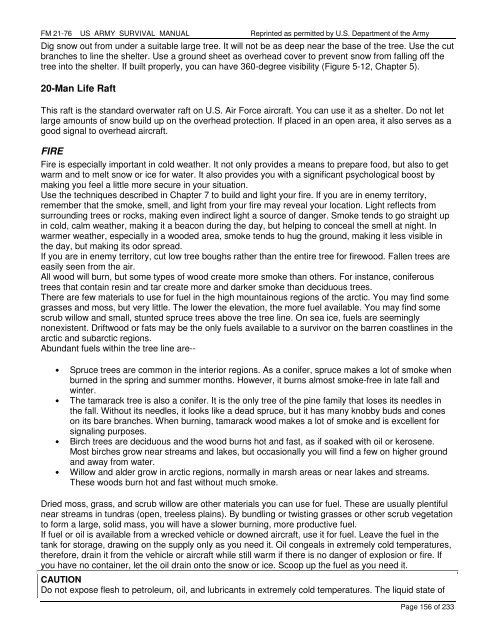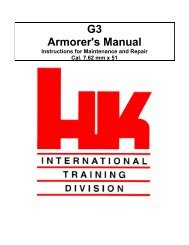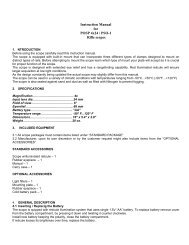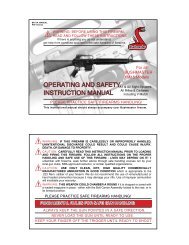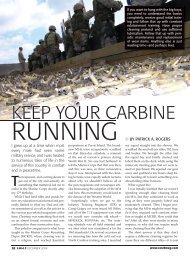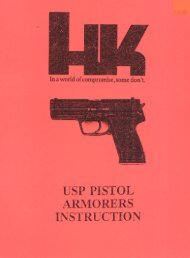FM 21-76 US ARMY SURVIVAL MANUAL - AR15.com
FM 21-76 US ARMY SURVIVAL MANUAL - AR15.com
FM 21-76 US ARMY SURVIVAL MANUAL - AR15.com
Create successful ePaper yourself
Turn your PDF publications into a flip-book with our unique Google optimized e-Paper software.
<strong>FM</strong> <strong>21</strong>-<strong>76</strong> <strong>US</strong> <strong>ARMY</strong> <strong>SURVIVAL</strong> <strong>MANUAL</strong> Reprinted as permitted by U.S. Department of the Army<br />
Dig snow out from under a suitable large tree. It will not be as deep near the base of the tree. Use the cut<br />
branches to line the shelter. Use a ground sheet as overhead cover to prevent snow from falling off the<br />
tree into the shelter. If built properly, you can have 360-degree visibility (Figure 5-12, Chapter 5).<br />
20-Man Life Raft<br />
This raft is the standard overwater raft on U.S. Air Force aircraft. You can use it as a shelter. Do not let<br />
large amounts of snow build up on the overhead protection. If placed in an open area, it also serves as a<br />
good signal to overhead aircraft.<br />
FIRE<br />
Fire is especially important in cold weather. It not only provides a means to prepare food, but also to get<br />
warm and to melt snow or ice for water. It also provides you with a significant psychological boost by<br />
making you feel a little more secure in your situation.<br />
Use the techniques described in Chapter 7 to build and light your fire. If you are in enemy territory,<br />
remember that the smoke, smell, and light from your fire may reveal your location. Light reflects from<br />
surrounding trees or rocks, making even indirect light a source of danger. Smoke tends to go straight up<br />
in cold, calm weather, making it a beacon during the day, but helping to conceal the smell at night. In<br />
warmer weather, especially in a wooded area, smoke tends to hug the ground, making it less visible in<br />
the day, but making its odor spread.<br />
If you are in enemy territory, cut low tree boughs rather than the entire tree for firewood. Fallen trees are<br />
easily seen from the air.<br />
All wood will burn, but some types of wood create more smoke than others. For instance, coniferous<br />
trees that contain resin and tar create more and darker smoke than deciduous trees.<br />
There are few materials to use for fuel in the high mountainous regions of the arctic. You may find some<br />
grasses and moss, but very little. The lower the elevation, the more fuel available. You may find some<br />
scrub willow and small, stunted spruce trees above the tree line. On sea ice, fuels are seemingly<br />
nonexistent. Driftwood or fats may be the only fuels available to a survivor on the barren coastlines in the<br />
arctic and subarctic regions.<br />
Abundant fuels within the tree line are--<br />
• Spruce trees are common in the interior regions. As a conifer, spruce makes a lot of smoke when<br />
burned in the spring and summer months. However, it burns almost smoke-free in late fall and<br />
winter.<br />
• The tamarack tree is also a conifer. It is the only tree of the pine family that loses its needles in<br />
the fall. Without its needles, it looks like a dead spruce, but it has many knobby buds and cones<br />
on its bare branches. When burning, tamarack wood makes a lot of smoke and is excellent for<br />
signaling purposes.<br />
• Birch trees are deciduous and the wood burns hot and fast, as if soaked with oil or kerosene.<br />
Most birches grow near streams and lakes, but occasionally you will find a few on higher ground<br />
and away from water.<br />
• Willow and alder grow in arctic regions, normally in marsh areas or near lakes and streams.<br />
These woods burn hot and fast without much smoke.<br />
Dried moss, grass, and scrub willow are other materials you can use for fuel. These are usually plentiful<br />
near streams in tundras (open, treeless plains). By bundling or twisting grasses or other scrub vegetation<br />
to form a large, solid mass, you will have a slower burning, more productive fuel.<br />
If fuel or oil is available from a wrecked vehicle or downed aircraft, use it for fuel. Leave the fuel in the<br />
tank for storage, drawing on the supply only as you need it. Oil congeals in extremely cold temperatures,<br />
therefore, drain it from the vehicle or aircraft while still warm if there is no danger of explosion or fire. If<br />
you have no container, let the oil drain onto the snow or ice. Scoop up the fuel as you need it.<br />
CAUTION<br />
Do not expose flesh to petroleum, oil, and lubricants in extremely cold temperatures. The liquid state of<br />
Page 156 of 233


